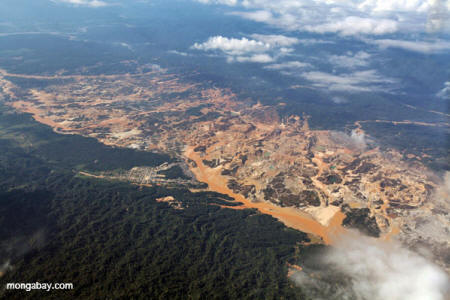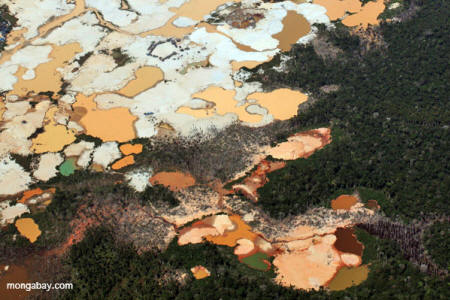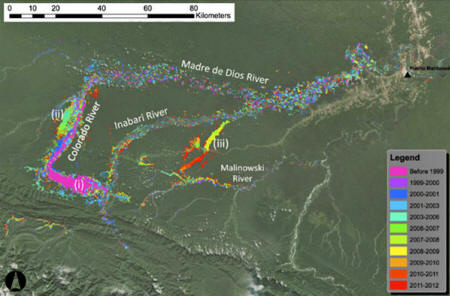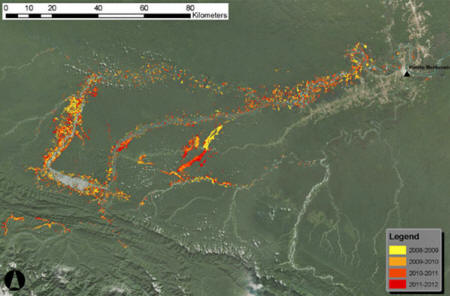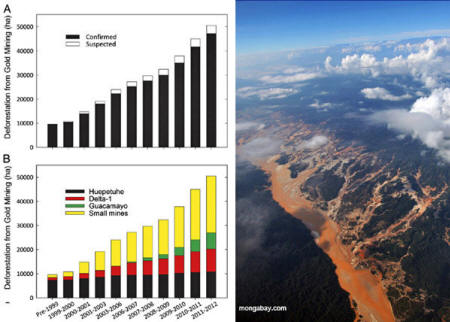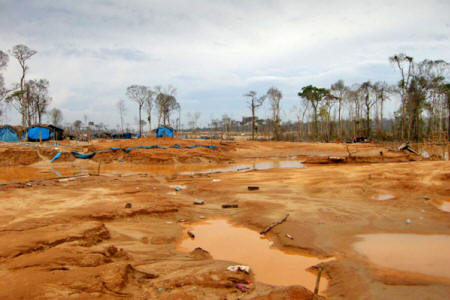|
|
|
October 28, 2013
The extent of gold mining in the Peruvian Amazon has surged 400 percent since 1999 due to rocketing gold prices, wreaking havoc on forests and devastating local rivers, finds a new study (Elevated Rates of Gold Mining in the Amazon Revealed through High-Resolution Monitoring) published in the Proceedings of the National Academy of Sciences (PNAS).
The assessment, led by Greg Asner of the Carnegie Institution for Science, is based on a combination of satellite imagery, on-the-ground field surveys, and an advanced airplane-based sensor that can accurately measure the rainforest canopy and sub-canopy vegetation at a resolution of 1.1 meters (42 inches).
The approach enabled the researchers to detect changes in forest cover in areas as small as 10 square meters, roughly 100 square feet, allowing them to map thousands of small, clandestine mines that had never before been detected at scale.
Gold mining in the Peruvian Amazon. Photo by Rhett A. Butler
The results are sobering: the extent of gold mines in the Madre de Dios region of Peru increased from less than 10,000 hectares in 1999 to more than 50,000 ha as of September 2012.
The rate of expansion jumped from 5,350 acres (2,166 ha) per year before 2008 to 15,180 acres (6,145 ha) per year thereafter. Surging gold prices, combined with increased access to the region granted by new roads, are thought to be driving the spike in mining activity.
The regional extent and occurrence of small and large mines throughout the southern Madre de Dios region.
The findings are significant because environmental damage from mining extends far beyond forest loss - mining destroys rivers, exacerbates hunting, and sends toxic waste downstream toward villages and towns.
Other studies have found high mercury levels in fish and human populations in and around Puerto Maldonado, a major city down-river from several major mining sites. Other research suggests that the effects of mining could last decades: a paper, also published today in PNAS, shows that mercury from the mid-19th century Gold Rush in California continues to contaminate agricultural areas in the state's rich central valley.
The long-term ramifications for the Peruvian Amazon, which has some of the highest levels of biodiversity ever recorded, are still largely unknown.
(A) Confirmed and suspected deforestation caused directly by gold mining in the southern Madre de Dios region from 1999 to 2012. (B) Contribution of the three large mines compared with small mines from 1999 to 2012. Courtesy of Asner et al 2013. RIGHT: Gold mining in the Peruvian Amazon. Photo by Rhett A. Butler
Asner's paper, which is co-authored with researchers from Carnegie and Peru's Ministry of Environment, comes as tensions over illegal gold mining in Peru are rising.
In late September several associations of informal gold miners launched a "strike" in Madre de Dios, blocking roads, threatening to attack a water processing plant, and assaulting a small farming town along the Interoceanic Highway.
The Ministry of Environment had to deploy security forces to protect its offices in Lima and Puerto Maldonado.
Undeterred, study co-author Ernesto Raez Luna, a senior advisor to Peru's Minister of Environment, says the research will enable to government to take action against illegal mining.
View of gold mining from the ground in Peru. Photo courtesy of Greg Asner http://news.mongabay.com/2012/0315-ashe_goldmining_peru.html
Informal gold mining isn't limited to Madre de Dios or even the Peruvian Amazon.
High gold prices have spurred illicit mining in rainforests around the world, including,
Güido Lombardi voiceover detailing the damage caused by gold mining in Madre de Dios in southeastern Peru (Spanish)
Reference
|


